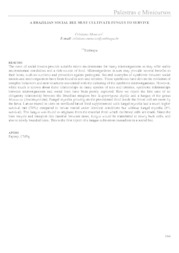Brazilian social bee must cultivate fungus to survive.
Brazilian social bee must cultivate fungus to survive.
Autoria: MENEZES, C.
Resumo: Resumo: The nests of social insects provide suitable micro-environments for many microorganisms as they offer stable environmental conditions and a rich source of food. Microorganisms in turn may provide several benefits to their hosts, such as nutrients and protection against pathogens. Several examples of symbiosis between social insects and microorganisms have been found in ants and termites. These symbioses have driven the evolution of complex behaviors and nest structures associated with the culturing of the symbiotic microorganisms. However, while much is known about these relationships in many species of ants and termites, symbiotic relationships between microorganisms and social bees have been poorly explored. Here we report the first case of an obligatory relationship between the Brazilian stingless bee Scaptotrigona depilis and a fungus of the genus Monascus (Ascomycotina). Fungal mycelia growing on the provisioned food inside the brood cell are eaten by the larva. Larvae reared in vitro on sterilized larval food supplemented with fungal mycelia had a much higher survival rate (76%) compared to larvae reared under identical conditions but without fungal mycelia (8% survival). The fungus was found to originate from the material from which the brood cells are made. Since the bees recycle and transport this material between nests, fungus would be transferred to newly built cells, and also to newly founded nests. This is the first report of a fungus cultivation mutualism in a social bee.
Ano de publicação: 2016
Tipo de publicação: Resumo em anais e proceedings
Unidade: Embrapa Meio Ambiente
Palavras-chave: Abelha, Abelha sem ferrão
Observações
1 - Por padrão são exibidas publicações dos últimos 20 anos. Para encontrar publicações mais antigas, configure o filtro ano de publicação, colocando o ano a partir do qual você deseja encontrar publicações. O filtro está na coluna da esquerda na busca acima.
2 - Para ler algumas publicações da Embrapa (apenas as que estão em formato ePub), é necessário ter, no celular ou computador, um desses softwares gratuitos. Sistemas Android: Google Play Livros; IOS: iBooks; Windows e Linux: software Calibre.
Acesse outras publicações
Acesse a Base de Dados da Pesquisa Agropecuária (BDPA) para consultar o acervo completo das bibliotecas da Embrapa.

